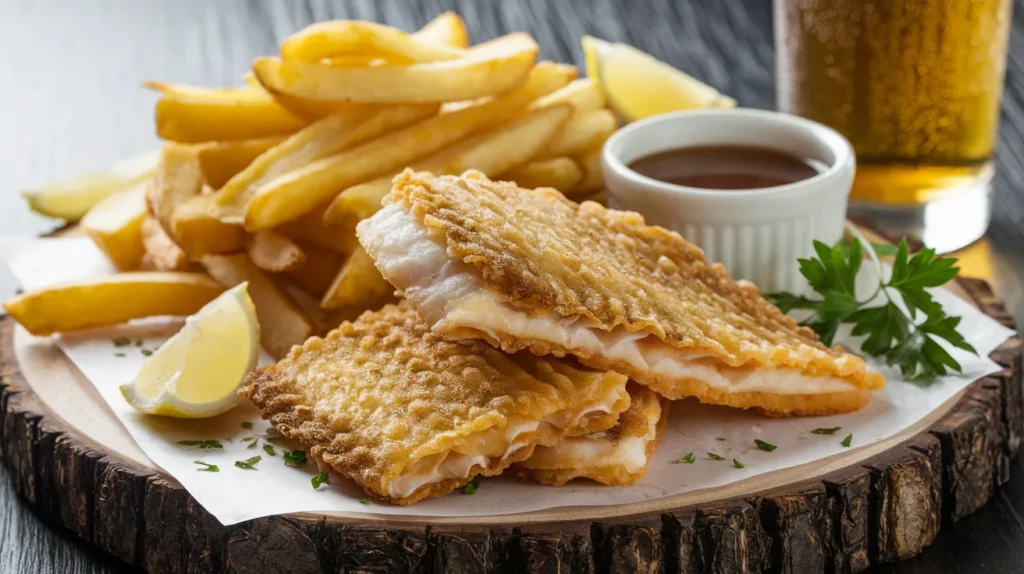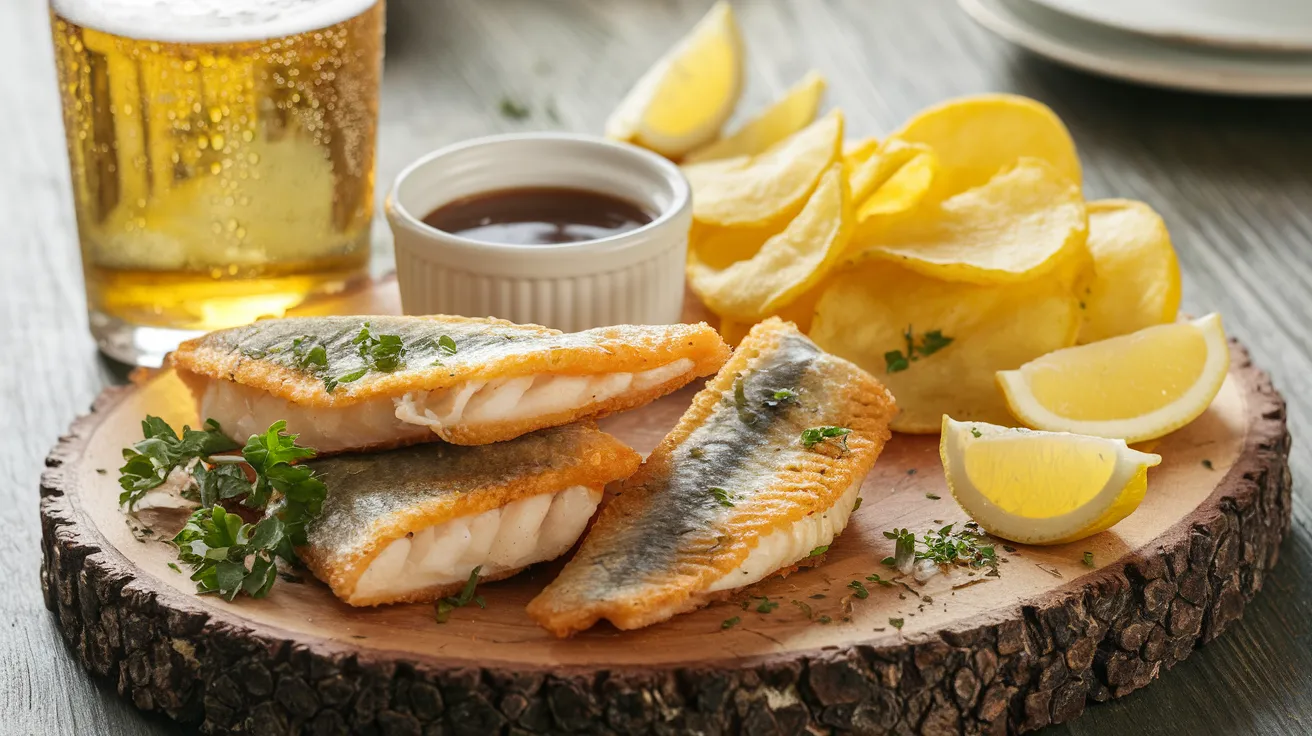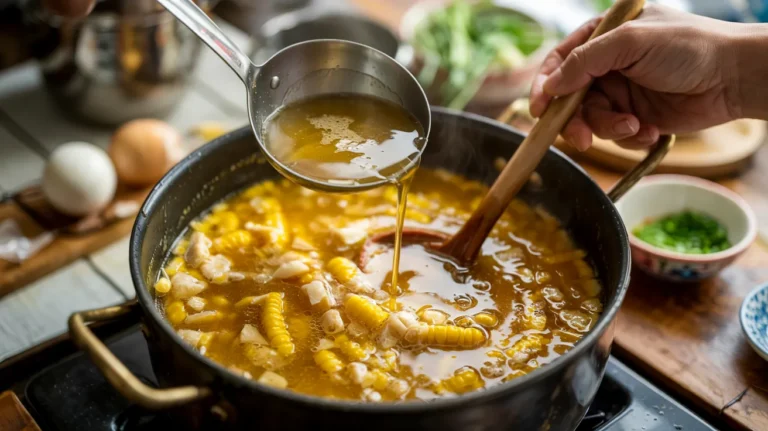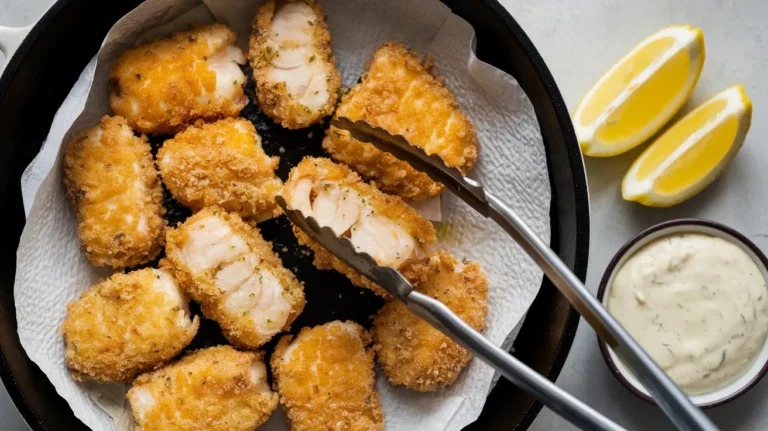Key Takeaways for Super Crispy Fish And Chips
- Double-dipping creates an ultra-crispy coating that stays crunchy for hours
- Cold soda water and cornstarch are the secret to the crunchiest batter
- Pre-soaking potatoes removes excess starch for perfectly crisp fries
- Cook fish and chips separately at different temperatures for best results
Why Your Homemade Super Crispy Fish And Chips Fall Flat
Ever tried making fish and chips at home only to end up with soggy batter and limp fries? You’re not alone.
Most home cooks struggle to achieve that perfect crunch that makes restaurant-quality Super Crispy Fish And Chips so satisfying.
The solution? A few chef-tested techniques and the right ingredients. Our Super Crispy Fish And Chips recipe delivers restaurant-quality results with techniques anyone can master. If you’re a fan of fish dishes, you might also enjoy my homemade fish nuggets for another crispy option that’s perfect for weeknight dinners.
Nutrition Information
| Nutrient | Amount per Serving |
|---|---|
| Calories | 620 |
| Protein | 28g |
| Fat | 32g |
| Carbohydrates | 58g |
| Fiber | 4g |
| Sodium | 580mg |
| Cholesterol | 65mg |
Serving size: 1 fish fillet with approximately 1 cup of chips
What You’ll Need
Ingredients
| Ingredient | Amount | Purpose |
|---|---|---|
| Firm white fish (cod or haddock) | 1½ pounds (4 fillets) | Main protein |
| Russet potatoes | 2 pounds | For chips |
| All-purpose flour | 1½ cups | Batter base |
| Cornstarch | ¼ cup | Creates crispiness |
| Baking powder | 1 tablespoon | Helps batter puff |
| Cold soda water | 1½ cups | Creates light texture |
| Salt | 1 tablespoon (divided) | Seasoning |
| Black pepper | 1 teaspoon | Seasoning |
| Paprika | 1 teaspoon | Adds color and flavor |
| Vegetable oil | 4 cups | For frying |
| Lemon wedges | 1 lemon, cut into wedges | Serving |
| Malt vinegar | ¼ cup | Serving |
| Fresh parsley, chopped | 2 tablespoons | Garnish |
Equipment
| Tool | Purpose |
|---|---|
| Large heavy-bottomed pot or deep fryer | For frying |
| Candy/oil thermometer | Monitor oil temperature |
| Baking sheet with wire rack | Draining and keeping crisp |
| Large mixing bowl | For batter |
| Sharp knife | Cutting potatoes |
| Kitchen paper | Draining excess oil |
| Slotted spoon or spider | Removing food from oil |
| Medium bowl | Soaking potatoes |
Possible Substitutions
- Fish: Any firm white fish works – try pollock, tilapia, or halibut
- Soda water: Plain cold water with 1 teaspoon of baking soda can work in a pinch
- Cornstarch: Rice flour makes an excellent substitute
- Russet potatoes: Yukon Gold will work but won’t be quite as crispy
- Vegetable oil: Peanut oil or canola oil are great alternatives
Preparation Time
- Prep time: 30 minutes (includes potato soaking)
- Cook time: 25 minutes
- Total time: 55 minutes
- Servings: 4 persons
Step-by-Step Instructions
Preparing the Chips
- Wash and peel the potatoes
- Place potatoes under cold running water and scrub gently with a vegetable brush to remove dirt
- Using a vegetable peeler, remove the skin by holding the potato in one hand and peeling away from you with the other
- Rinse peeled potatoes again to remove any leftover peel
- Cut the potatoes into sticks
- Place a potato on a cutting board and slice it lengthwise into ½-inch thick slabs
- Lay each slab flat and cut into ½-inch strips to form sticks
- Repeat with all potatoes, trying to keep the size consistent for even cooking
- Beginner tip: If your knife skills aren’t perfect, don’t worry! Just try to keep thickness similar
- Soak the potatoes to remove starch
- Fill a large bowl with cold water (ice water works even better)
- Add the cut potato sticks to the water
- Let them soak for at least 30 minutes, but preferably 1-2 hours
- Why this matters: Soaking removes excess starch, which is the key to crispy rather than soggy fries
- Change the water after 30 minutes if it becomes very cloudy
- Drain and dry the potatoes thoroughly
- Pour potatoes into a colander to drain water
- Spread potatoes on clean kitchen towels or paper towels
- Pat completely dry with additional towels
- Critical step: Any moisture will cause the oil to splatter dangerously and make your chips soggy
- Let potatoes air dry for 5 minutes after patting for extra insurance
Preparing the Fish for Super Crispy Fish And Chips
- Prepare your fish fillets
- Unwrap fish and check for any remaining scales or bones
- Run your fingers gently over the flesh to feel for bones and remove any with tweezers
- Cut the fish into 4 equal portions (about 6 ounces each)
- Beginner tip: If fillets are uneven in thickness, make a small slice in the thickest part to help it cook evenly
- If you enjoy working with fish fillets, you might like my fish fillet in sweet corn sauce recipe for a different flavor profile
- Dry and season the fish
- Place fish on a plate lined with paper towels
- Pat each piece thoroughly dry on all sides with additional paper towels
- Sprinkle ½ teaspoon salt and ¼ teaspoon pepper evenly over all fish pieces
- Why this matters: Proper drying ensures the batter will stick and not slide off during frying
- Set up your frying station
- Choose a work area with plenty of counter space
- Place your cooktop/fryer on one side
- Set up: raw fish plate → flour plate → batter bowl → empty plate for battered fish → cooking pot → cooling rack
- Line a baking sheet with paper towels and set wire rack on top
- Have your thermometer, timer, and spider/slotted spoon within easy reach
- Safety tip: Clear away any clutter and keep paper products away from heat source
Making the Perfect Batter
- Measure and mix dry batter ingredients
- In a large bowl, add exactly 1 cup all-purpose flour (spooned and leveled)
- Add ¼ cup cornstarch (the secret to crispiness!)
- Add 1 teaspoon baking powder (measured with proper measuring spoon)
- Add 1 teaspoon salt
- Add ½ teaspoon black pepper
- Add 1 teaspoon paprika
- Whisk all dry ingredients together until evenly combined and no lumps remain
- Beginner tip: Sift ingredients for extra insurance against lumps
- Add wet ingredients to create batter
- Measure 1½ cups soda water (must be very cold – refrigerate for at least 1 hour before using)
- Pour soda water into dry ingredients
- Using a whisk, mix with gentle strokes just until combined
- Stop mixing when most lumps are gone but a few small ones remain
- Why this matters: Overmixing develops gluten, making batter tough instead of light and crispy
- The batter should have the consistency of pancake batter – coat the back of a spoon but run off easily
- Prepare the pre-coating flour
- Put remaining ½ cup flour on a flat plate or shallow dish
- Add a pinch of salt and pepper and mix with your fingers
- Spread flour evenly across the plate
- Beginner tip: This pre-coating is essential – it helps the batter stick to the fish
Frying the Chips (First Fry)
- Heat the oil for first fry
- Select a heavy-bottomed pot at least 6 inches deep
- Pour 4 cups vegetable oil into pot (should reach 3 inches depth)
- Clip candy/oil thermometer to side of pot (make sure tip doesn’t touch bottom)
- Heat oil over medium heat to exactly 325°F
- Safety warning: Never leave hot oil unattended, keep pot handle turned inward, and have a lid nearby
- First fry for chips (blanching)
- Make sure potatoes are completely dry
- Carefully lower half the potato sticks into oil using a slotted spoon or spider
- Do not drop from height – place them in gently to prevent splashing
- Stir gently with spider to prevent sticking
- Fry for 4-5 minutes until potatoes are soft but not browned (they should look pale)
- Beginner tip: This first fry cooks the inside without browning the outside
- Remove and drain first batch
- Carefully lift potatoes from oil using slotted spoon or spider
- Hold above pot for 5 seconds to let excess oil drip back
- Transfer to paper towel-lined plate
- Spread out to cool slightly
- Return oil to 325°F before cooking second batch
- Repeat steps 12-13 with remaining potato sticks
Frying the Chips (Second Fry)
- Increase oil temperature for second fry
- After all potatoes have been blanched, increase heat
- Bring oil to exactly 375°F (use thermometer to verify)
- Why this matters: The higher temperature creates the crispy exterior while the inside is already cooked
- Second fry for extra crispiness
- Once oil reaches 375°F, add first batch of blanched potatoes back to oil
- Fry for 2-3 minutes, stirring occasionally, until golden brown and visibly crispy
- Watch carefully as they can go from perfect to burnt quickly
- Beginner tip: Listen for the sizzle to quiet down – that means moisture is gone and they’re getting crispy
- Drain and season chips immediately
- Remove golden chips to wire rack (not paper towels this time)
- Sprinkle with salt while still hot (about ¼ teaspoon per batch)
- Toss gently to distribute salt
- Why wire rack: Keeps them crispy; paper towels would trap steam and make them soggy
- Repeat with remaining blanched potatoes
Frying the Fish for Perfect Super Crispy Fish And Chips
- Adjust oil temperature for fish
- Allow oil to cool slightly to exactly 350°F
- Check with thermometer and adjust heat as needed
- Critical step: Fish needs slightly lower temperature than final chip fry to cook through without burning
- Coat fish with flour and batter
- Take one fish piece and place in plate of plain flour
- Coat completely, including all sides and crevices
- Gently shake off excess flour
- Dip floured fish into batter, using fingers or tongs
- Turn to coat completely
- Lift and hold above bowl for 5 seconds to let excess batter drip off
- Beginner tip: Too much batter will create a doughy coating instead of crispy one
- Fry fish carefully
- Check that oil is at 350°F
- Hold battered fish just above oil surface and slide in gently away from you
- Fry only 2 pieces at a time (overcrowding lowers oil temperature)
- Cook for 3 minutes on first side
- Using slotted spoon or spider, carefully flip fish over
- Cook additional 2-3 minutes until deeply golden and crisp
- How to tell it’s done: Batter should be amber-golden and crispy, and fish should flake easily with a fork
- For absolute certainty, use instant-read thermometer to check for internal temperature of 145°F
- Drain and keep fish warm
- Carefully remove fish to wire rack (not paper towels)
- Let drain for 30 seconds
- Transfer to 200°F oven to keep warm while cooking remaining fish
- Beginner tip: Place fish in single layer, not stacked, to maintain crispiness
- Return oil to 350°F before adding next batch
Serving Your Meal
- Plate your fish and chips
- Warm your serving plates slightly for 1 minute in the oven (optional)
- Place a portion of chips on one side of each plate
- Lay fish fillet alongside chips
- Make sure nothing is stacked to preserve crispiness
- Add final touches
- Sprinkle fish with a tiny pinch of flaky salt if desired
- Scatter chopped parsley over both fish and chips
- Place lemon wedge on each plate
- Pour malt vinegar into small serving bowls or ramekins
- Beginner tip: Traditional serving includes malt vinegar for chips and lemon for fish

Troubleshooting
Common Issues and Solutions
Problem: Soggy batter that doesn’t crisp up
- Cause: Oil not hot enough before adding fish
- Solution: Use thermometer to verify oil is exactly 350°F
- Cause: Fish not dried properly before battering
- Solution: Pat fish dry with paper towels until no moisture remains
- Cause: Batter too thick or thin
- Solution: Batter should coat the back of a spoon but still run off easily
Problem: Greasy, oily chips
- Cause: Oil temperature too low during second fry
- Solution: Make sure second fry is at full 375°F
- Cause: Not draining properly after frying
- Solution: Use wire rack instead of paper towels for final draining
- Cause: Frying too many potatoes at once
- Solution: Fry in smaller batches – potatoes should float freely in oil
Problem: Batter falls off fish during frying
- Cause: Fish surface too wet before coating
- Solution: Pat fish completely dry before dredging in flour
- Cause: Not dredging in flour before battering
- Solution: Always coat in plain flour first, then batter
- Cause: Oil not hot enough when fish added
- Solution: Verify 350°F temperature with thermometer
Problem: Chips not crispy enough
- Cause: Potatoes not soaked long enough
- Solution: Soak at least 30 minutes, preferably 1-2 hours
- Cause: Potatoes not dried thoroughly after soaking
- Solution: Dry with multiple paper towels until completely dry
- Cause: Second fry temperature too low
- Solution: Make sure oil reaches full 375°F before second fry
Variations & Substitutions for Super Crispy Fish And Chips
Make It Your Own
Beer Batter Version
- Replace soda water with 1½ cups cold beer (lager works best)
- Add 1 teaspoon garlic powder to the batter
- The beer adds flavor and the carbon dioxide helps create a lighter texture
- For a different soup-based fish dish, try my corn and fish maw soup for a comforting meal option
Spicy Fish
- Add ½ teaspoon cayenne pepper to the batter
- Serve with spicy mayo (mix ½ cup mayo with 1 tablespoon hot sauce)
- Garnish with sliced fresh chili peppers for extra heat
Herb-Infused
- Add 2 tablespoons fresh chopped dill or parsley to the batter
- Sprinkle fish with more herbs after frying
- Excellent with a homemade tartar sauce (mix ½ cup mayo, 2 tbsp chopped pickles, 1 tbsp lemon juice)
Gluten-Free Option
- Replace all-purpose flour with gluten-free flour blend
- Add ½ teaspoon xanthan gum to help binding
- Ensure your baking powder is gluten-free certified
Storage & Reheating
Keep That Crunch
Storage
- Fish and chips are best eaten immediately while hot and crispy
- If needed, store fish and chips separately in airtight containers
- Refrigerate for up to 2 days maximum
- Important note: The texture will never be as good as fresh-made
- Place paper towels under and over fish to absorb moisture
Reheating Fish
- Preheat oven to 350°F
- Remove fish from refrigerator 10 minutes before reheating
- Place fish on wire rack over baking sheet (never microwave!)
- Heat for 10-15 minutes until warmed through and re-crisped
- Check that internal temperature reaches 145°F
Reheating Chips
- Preheat oven to 400°F
- Spread chips in single layer on baking sheet
- Reheat for 5-7 minutes until hot and crisp
- Never microwave – they’ll become soggy and unpleasant
- A quick refry in hot oil (375°F for 10-20 seconds) also works perfectly
Safety Notes & Tips
Frying Safety First
- Never fill pot more than halfway with oil (to prevent boiling over)
- Keep a metal lid nearby to cover pot if oil catches fire (never use water!)
- Keep a box of baking soda nearby as backup fire suppressant
- Never add water to hot oil – it will explode dangerously
- Keep a Class K fire extinguisher in your kitchen if possible
- Use long-handled tools to prevent splatter burns on hands
- Turn pot handles away from the edge of stove to prevent accidental tipping
- Never leave hot oil unattended, even for a minute
- Allow oil to cool completely before disposing or storing
Pro Tips
- For extra crispy fish: Let battered fish rest on wire rack for 2 minutes before frying to set the coating
- Even cooking: Keep fish pieces similar in thickness – cut thicker parts slightly if needed
- Temperature control: Use a good oil thermometer and adjust heat as needed throughout cooking
- Test batter: Before adding fish, drop a small amount of batter into oil – it should sizzle immediately and float to the surface
- Maintain oil quality: Strain cooled oil through cheesecloth and store for next use (can be reused up to 3 times)
- Maximum crispiness: Serve immediately after cooking – crispiness decreases with every passing minute
- Cleanup tip: Add potato peels to compost rather than garbage disposal
Dietary notes: This recipe contains gluten and fish. For dairy-free, ensure all ingredients are dairy-free.




